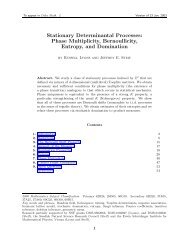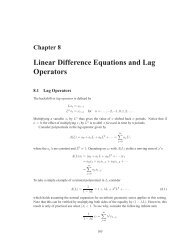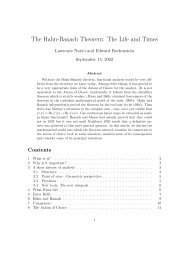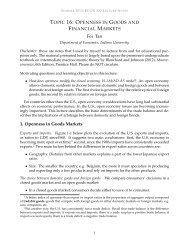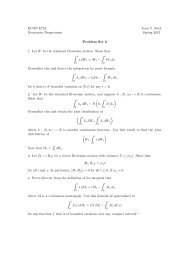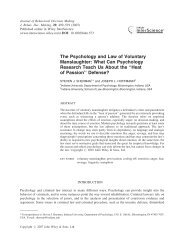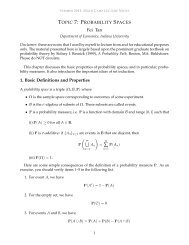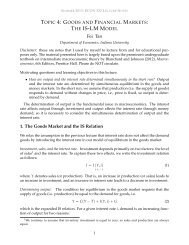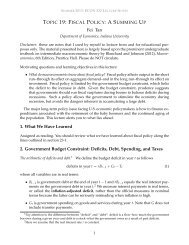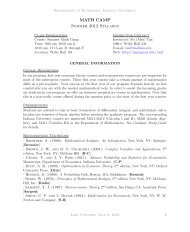Answer Key - Mypage
Answer Key - Mypage
Answer Key - Mypage
Create successful ePaper yourself
Turn your PDF publications into a flip-book with our unique Google optimized e-Paper software.
E724 Financial Econometrics (Spring 2013) Problem Set 3<br />
Instructor: Prof. Joon Park<br />
By Ye Lu<br />
February 16, 2013<br />
Problem 1. Let W be the standard Brownian motion. Show that<br />
t<br />
t<br />
sdWs = tWt − Wsds.<br />
Generalize this and derive the integration by parts formula<br />
t<br />
t<br />
hsdWs = htWt − Wsdhs<br />
for h that is of bounded variation on [0, t] for any t > 0.<br />
0<br />
0<br />
Solution 1. Applying Ito’s formula to f(t, Wt) = tWt to obtain that<br />
Integrating on both sides yields<br />
That is,<br />
df(t, Wt) = d(tWt) = Wtdt + tdWt.<br />
t t<br />
tWt = Wsds + sdWs.<br />
0<br />
t<br />
t<br />
sdWs = tWt − Wsds.<br />
0<br />
We can easily generalize this result for h that is of bounded variation on [0, t] for any t > 0:<br />
d(htWt) = Wtdht + htdWt.<br />
Integrating on both sides yields<br />
t t<br />
htWt = Wsdhs + hsdWs.<br />
That is,<br />
0<br />
t<br />
t<br />
hsdWs = htWt − Wsdhs.<br />
0<br />
1<br />
0<br />
0<br />
0<br />
0<br />
0<br />
0
2<br />
Problem 2. Let W be the standard Brownian motion, and suppose h : [0, ∞) → R is continuous.<br />
Show that<br />
t<br />
t<br />
hsdWs ∼ N 0, h 2 <br />
sds .<br />
Generalize this and obtain the joint distribution of<br />
t t <br />
hsdWs, ksdWs<br />
0<br />
0<br />
where k : [0, ∞) → R is another continuous function. Use this result to find the joint distribution<br />
of<br />
t <br />
Wt, sdWs .<br />
Note that Wt = t<br />
0 dWs.<br />
Solution 2. (i) Firstly we show that<br />
t<br />
t<br />
hsdWs ∼ N 0,<br />
0<br />
0<br />
0<br />
0<br />
0<br />
h 2 <br />
sds .<br />
Let Pt = t<br />
0 hsdWs, it suffices to show the moment generating function of Pt has the<br />
following form:<br />
E(e uPt <br />
) = E exp(u<br />
t<br />
0<br />
<br />
hsdWs)<br />
<br />
= exp µu + 1<br />
2 σ2u 2<br />
<br />
<br />
1<br />
= exp<br />
2 u2<br />
t<br />
0<br />
h 2 <br />
sds ,<br />
which is equivalent to showing that<br />
t<br />
E exp(u hsdWs −<br />
0<br />
1<br />
2 u2<br />
t<br />
h<br />
0<br />
2 <br />
sds) = 1. (1)<br />
<br />
Denote Xt = exp u t<br />
0 hsdWs − 1<br />
2u2 t<br />
0 h2 <br />
sds and note that it is a martingale. Hence<br />
<br />
E(Xt) = E(X0) = E exp u<br />
which gives us equation (1) as desired.<br />
0<br />
0<br />
hsdWs − 1<br />
2 u2<br />
Below we show that X = (Xt) is a martingale process. Notice that<br />
t<br />
Xt = exp u hsdWs − 1<br />
2 u2<br />
t<br />
h 2 <br />
sds<br />
0<br />
0<br />
0<br />
0<br />
h 2 <br />
sds = E(e 0 ) = 1,
E724 Financial Econometrics (Spring 2013) Problem Set 3 3<br />
with X0 = 1 is a generalized geometric Brownian motion which is the solution to the<br />
stochastic differential equation<br />
dXt = uhtXtdWt. (2)<br />
To see this, we apply Ito formula and then plug in (2) to obtain<br />
d ln Xt = dXt<br />
Xt<br />
Integrating on both sides of (3) yields<br />
and thus<br />
With X0 = 1,<br />
From (2) we can see that<br />
t<br />
ln Xt − ln X0 = u<br />
<br />
Xt = X0 exp u<br />
<br />
Xt = exp u<br />
− 1 d[X]t<br />
2 X2 t<br />
= uhtdWt − 1<br />
2 u2 h 2 t dt (3)<br />
t<br />
t<br />
0<br />
0<br />
0<br />
Xt = X0 +<br />
hsdWs − 1<br />
2 u2<br />
hsdWs − 1<br />
2 u2<br />
hsdWs − 1<br />
2 u2<br />
t<br />
t<br />
h 2 sds,<br />
t<br />
0<br />
t<br />
uhsXsdWs<br />
0<br />
0<br />
0<br />
h 2 <br />
sds .<br />
h 2 <br />
sds .<br />
where the RHS of (4) is a constant plus an Ito integral, which turns out to be a martingale.<br />
This shows that (Xt) is a martingale.<br />
Given Pt follows normal distribution, then by computing its mean and variance:<br />
we have<br />
t <br />
E(Pt) = E hsdWs = 0<br />
0<br />
Var(Pt) = E (Pt) 2 t<br />
= E ([P ]t) = h 2 sds,<br />
t<br />
Pt =<br />
0<br />
<br />
hsdWs ∼ N 0,<br />
t<br />
0<br />
0<br />
h 2 <br />
sds .<br />
(4)
4<br />
(ii) Another way to show<br />
t<br />
Pt =<br />
0<br />
<br />
hsdWs ∼ N 0,<br />
t<br />
0<br />
h 2 <br />
sds .<br />
is given as follows. Let Pnt = n hti−1 (Wti i=1 − Wti−1 ). By definition of Ito integral,<br />
This implies<br />
Pnt →p Pt as πn → 0.<br />
Pnt →d Pt as πn → 0. (5)<br />
By the properties of Brownian motion, we know that<br />
<br />
n<br />
Pnt ∼ N 0, h 2 ti−1 (ti<br />
<br />
− ti−1)<br />
i=1<br />
Then the moment generating function of Pnt is given by<br />
Mn(u) = E e uPnt<br />
<br />
1<br />
= exp<br />
2 u2<br />
n<br />
h<br />
i=1<br />
2 ti−1 (ti<br />
<br />
− ti−1)<br />
<br />
1<br />
→ exp<br />
2 u2<br />
t<br />
h 2 <br />
sds ≡ M(u), as πn → 0. (6)<br />
0<br />
Since Xn →d X if and only if moment generating function of Xn converges to moment<br />
generating function of X, from (5) and (6) it follows that Pt <br />
must have moment generating<br />
function M(u) in (6). That is Pt ∼ N 0, t<br />
0 h2 <br />
sds as desired.<br />
(iii) Generalizing the above result, denote<br />
t t<br />
′<br />
Qt = hsdWs, ksdWs ,<br />
0<br />
and Qt follows multivariate normal distribution with mean and variance given by<br />
t t<br />
′<br />
E(Qt) = E hsdWs, ksdWs = (0, 0)<br />
0<br />
0<br />
′ ;<br />
Var(Qt) = E QtQ ′ <br />
t<br />
t = E ([Q]t) = 0 h2 t<br />
sds 0 hsksds<br />
<br />
.<br />
0<br />
t<br />
0 hsksds<br />
(iv) Specifically, the joint distribution of<br />
t t t <br />
Wt, sdWs = 1dWs, sdWs<br />
0<br />
0<br />
0<br />
t<br />
0 k2 sds
E724 Financial Econometrics (Spring 2013) Problem Set 3 5<br />
is<br />
0 t<br />
N , 0<br />
0<br />
ds<br />
t<br />
0 sds<br />
t<br />
0 sds t<br />
0 s2ds <br />
= N<br />
<br />
0<br />
,<br />
0<br />
t 1/2t 2<br />
1/2t 2 1/3t 3<br />
<br />
.<br />
Problem 3. Let Bt = (Bit) be a vector Brownian motion with variance Σ = (σij). Show that<br />
[Bi, Bj]t = σijt<br />
for all i and j. In particular, [Bi, Bj]t = 0 for all t ≥ 0, if σij = 0.<br />
Solution 3. We can solve this problem by two ways.<br />
(i) We can show that n <br />
Bi,tk k=1 − Bi,tk−1 Bj,tk − Bj,tk−1 →L2 σijt as πn → 0:<br />
<br />
n<br />
2 <br />
E Bi,tk − Bi,tk−1 Bj,tk − Bj,tk−1 − σijt<br />
= E<br />
= E<br />
=<br />
=<br />
=<br />
k=1<br />
n<br />
k=1<br />
n<br />
n<br />
k=1<br />
− 2<br />
<br />
Bi,tk − Bi,tk−1<br />
Bj,tk<br />
− Bj,tk−1<br />
<br />
Bi,tk − Bi,tk−1 Bj,tk − Bj,tk−1<br />
k=1<br />
Bi,tk 2 <br />
E − Bi,tk−1 Bj,tk − Bj,tk−1<br />
n<br />
σij(tk − tk−1)E Bi,tk<br />
k=1<br />
n<br />
(σiiσjj + 2σ 2 ij)(tk − tk−1) 2 − 2<br />
k=1<br />
n<br />
k=1<br />
(σiiσjj + σ 2 ij)(tk − tk−1) 2<br />
≤ (σiiσjj + σ 2 ij) max<br />
1≤k≤n |tk − tk−1|<br />
− Bi,tk−1<br />
− σij(tk − tk−1) 2<br />
− σij(tk − tk−1) 2<br />
2 <br />
Bj,tk<br />
− Bj,tk−1<br />
n<br />
σ 2 ij(tk − tk−1) 2 +<br />
k=1<br />
n<br />
(tk − tk−1)<br />
k=1<br />
<br />
+<br />
n<br />
k=1<br />
n<br />
k=1<br />
σ 2 ij(tk − tk−1) 2<br />
σ 2 ij(tk − tk−1) 2<br />
= t(σiiσjj + σ 2 ij) max<br />
1≤k≤n |tk − tk−1| → 0, as πn → 0.<br />
Therefore n <br />
Bi,tk k=1 − Bi,tk−1 Bj,tk − Bj,tk−1 →p σijt as πn → 0, thus<br />
[Bi, Bj]t = plim<br />
n<br />
<br />
Bi,tk − Bi,tk−1<br />
πn→0<br />
k=1<br />
Bj,tk<br />
− Bj,tk−1<br />
= σijt.
6<br />
(ii) Since Bt = (Bit) is a vector Brownian motion with variance Σ = (σij), it can be written<br />
as<br />
Bt = Σ 1/2 Wt<br />
where Wt = (Wit) is a vector of independent standard Brownian motions W1t, W2t, · · · , Wnt.<br />
Let<br />
It then follows that<br />
<br />
n<br />
[Bi, Bj]t =<br />
A = Σ 1/2 = (aij), and hence AA = AA ′ = Σ = (σij). (7)<br />
= 1<br />
4<br />
= 1<br />
4<br />
k=1<br />
k=1<br />
aikWk,<br />
n<br />
k=1<br />
ajkWk<br />
<br />
t<br />
<br />
n<br />
n<br />
<br />
aikWk + ajkWk −<br />
k=1<br />
k=1 t<br />
1<br />
<br />
n<br />
n<br />
aikWk −<br />
4<br />
k=1<br />
k=1<br />
<br />
n<br />
<br />
(aik + ajk)Wk − 1<br />
<br />
n<br />
<br />
(aik − ajk)Wk<br />
4<br />
t<br />
k=1<br />
= 1<br />
n<br />
(aik + ajk)<br />
4<br />
k=1<br />
2 [Wk]t − 1<br />
n<br />
4<br />
k=1<br />
= 1<br />
n <br />
(aik + ajk)<br />
4<br />
k=1<br />
2 − (aik − ajk) 2 [Wk]t<br />
= 1<br />
n<br />
4aikajk[Wk]t<br />
4<br />
k=1<br />
n<br />
=<br />
k=1<br />
(aik − ajk) 2 [Wk]t<br />
t<br />
ajkWk<br />
aikajkt = σijt (9)<br />
where (9) is obtained from (7), and (8) is obtain by the fact that<br />
[X, Y ]t = 1<br />
4 ([X + Y ]t − [X − Y ]t) .<br />
Problem 4. Prove directly from the definition of Ito integrals that<br />
t<br />
t<br />
sdMs = tMt − Msds,<br />
0<br />
where M is a continuous martingale. Can this formula be generalized to<br />
t<br />
t<br />
f(s)dMs = f(t)Mt Msdf(s)<br />
0<br />
for any function f that is of bounded variation over any compact interval?<br />
0<br />
0<br />
<br />
t<br />
(8)
E724 Financial Econometrics (Spring 2013) Problem Set 3 7<br />
Solution 4. By definition of Ito integral,<br />
Similarly,<br />
t<br />
0<br />
t<br />
0<br />
sdMs = plim<br />
πn→0<br />
f(s)dMs = plim<br />
πn→0<br />
n<br />
ti−1(Mti<br />
i=1<br />
n <br />
ti−1Mti<br />
− Mti−1 )<br />
<br />
= plim<br />
− tiMti + tiMti − ti−1Mti−1<br />
πn→0<br />
i=1<br />
n <br />
= plim (tiMti − ti−1Mti−1 ) − (tiMti − ti−1Mti )<br />
πn→0<br />
i=1<br />
n<br />
n<br />
= plim (tiMti − ti−1Mti−1 ) − plim Mti<br />
πn→0<br />
πn→0<br />
i=1<br />
i=1<br />
(ti − ti−1)<br />
t t<br />
= d(sMs) − Msds<br />
0<br />
t<br />
0<br />
= tMt − Msds.<br />
0<br />
n<br />
f(ti−1)(Mti − Mti−1 )<br />
i=1<br />
n <br />
f(ti−1)Mti<br />
<br />
= plim<br />
− f(ti)Mti + f(ti)Mti − f(ti−1)Mti−1<br />
πn→0<br />
i=1<br />
n <br />
= plim (f(ti)Mti − f(ti−1)Mti−1 ) − (f(ti)Mti − f(ti−1)Mti )<br />
πn→0<br />
i=1<br />
n<br />
n<br />
= plim (f(ti)Mti − f(ti−1)Mti−1 ) − plim Mti<br />
πn→0<br />
πn→0<br />
i=1<br />
i=1<br />
(f(ti) − f(ti−1))<br />
t<br />
t<br />
= d(f(s)Ms) − Msdf(s)<br />
0<br />
t<br />
0<br />
= f(t)Mt − Msdf(s),<br />
0<br />
for any function f that is of bounded variation over any compact interval.<br />
Problem 5. Check whether the following processes X are martingales with respect to the<br />
filtration (Ft) generated by the standard Brownian motion W (for (a) - (c)), or the two<br />
independent standard Brownian motions W and V (for (d)).<br />
(a) Xt = Wt + 4t<br />
(b) Xt = W 3 t − 3tWt
8<br />
(c) Xt = t 2 Wt − 2 t<br />
0 sWsds<br />
(d) Xt = WtVt<br />
Solution 5. (a) Note that for s < t,<br />
E (Xt|Fs) = E (Wt + 4t|Fs) = Ws + 4t = Xs.<br />
Therefore X is not a martingale with respect to Ft.<br />
(b) Apply Ito formula to obtain that<br />
Then<br />
dXt = (3W 2 t − 3t)dWt − 3Wtdt + 1<br />
· 6Wtdt<br />
2<br />
= 3(W 2 t − t)dWt.<br />
Xt = X0 + 3<br />
t<br />
(W 2 s − s)dWs,<br />
0<br />
which shows that Xt is constant plus a continuous martingale. So X is a martingale with<br />
respect to Ft.<br />
(c) Apply Ito formula to obtain that<br />
Then<br />
dXt = t 2 dWt + (2tWt − 2tWt) dt = t 2 dWt.<br />
Xt = X0 +<br />
t<br />
s 2 dWs,<br />
which shows that Xt is constant plus a continuous martingale. So X is a martingale with<br />
respect to Ft.<br />
(d) Since W and V are independent to each other, we have [W, V ]t = 0. Then by applying Ito<br />
formula, we obtain that<br />
Then<br />
Xt = X0 +<br />
dXt = WtdVt + VtdWt.<br />
0<br />
t t<br />
WsdVs + VsdWs,<br />
0<br />
which shows that Xt is constant plus two continuous martingales. So X is a martingale<br />
with respect to Ft.<br />
0
E724 Financial Econometrics (Spring 2013) Problem Set 3 9<br />
Problem 6. Let B be the m-dimensional standard vector Brownian motion, i.e., B is defined<br />
by B = (B1, · · · , B ′ ) , where Bi’s are independent standard Brownian motions. Use Ito’s formula<br />
to write the following n-dimensional stochastic process X on the standard form<br />
for suitable choice of u ∈ R n and v ∈ R n×m .<br />
(a) Xt = B 2 t , where B is 1-dimensional<br />
dXt = u(t, ω)dt + v(t, ω)dBt<br />
(b) Xt = 2 + t + e Bt , where B is 1-dimensional<br />
(c) Xt = (t, B 2 1t + B2 2t )′ , where B = (B1, B2) ′ is 2-dimensional<br />
(d) Xt = (B1t + B2t + B3t, B 2 2t − B1tB3t) ′ , where B = (B1, B2, B3) ′ is 3-dimensional<br />
Solution 6. (a) Applying Ito’s formula,<br />
Therefore we have<br />
(b) Applying Ito’s formula,<br />
Therefore we have<br />
(c) Applying Ito’s formula,<br />
<br />
t<br />
dXt = d<br />
B2 1t + B2 <br />
2t<br />
<br />
1 0 0<br />
= dt +<br />
0<br />
<br />
1 0 0<br />
= dt +<br />
2<br />
Therefore we have<br />
dXt = 2BtdBt + d[B]t = dt + 2BtdBt.<br />
u(t, ω) = 1, v(t, w) = 2Bt.<br />
dXt = dt + e Bt dBt + 1<br />
2 eBtd[B]t <br />
= 1 + 1<br />
2 eBt<br />
<br />
dt + e Bt dBt.<br />
u(t, ω) = 1 + 1<br />
2 eBt , v(t, w) = e Bt .<br />
u(t, ω) =<br />
2B1t 2B2t<br />
2B1t 2B2t<br />
<br />
d<br />
<br />
B1t<br />
dBt<br />
B2t<br />
<br />
0 0 [B1]t<br />
+ d<br />
1 1 [B2]t<br />
<br />
<br />
1<br />
0 0<br />
, v(t, w) =<br />
.<br />
2<br />
2B1t 2B2t
10<br />
(d) Applying Ito’s formula,<br />
<br />
B1t + B2t + B3t<br />
dXt = d<br />
Therefore we have<br />
B2 2t − B1tB3t<br />
⎛ ⎞<br />
⎛ ⎞<br />
B1t [B1]t<br />
1 1 1<br />
=<br />
d ⎝B2t⎠<br />
0 0 0<br />
+<br />
d ⎝[B2]t⎠<br />
−B3t 2B2t −B1t<br />
0 1 0<br />
B3t<br />
[B3]t<br />
<br />
0 1 1 1<br />
= dt +<br />
dBt<br />
1<br />
u(t, ω) =<br />
−B3t 2B2t −B1t<br />
<br />
<br />
0<br />
1 1 1<br />
, v(t, w) =<br />
.<br />
1<br />
−B3t 2B2t −B1t<br />
Problem 7. Let W be the standard Brownian modtion. Verify that the given processes solve<br />
the given corresponding stochastic differential equations.<br />
(a) Xt = e Wt solves<br />
for t > 0.<br />
(b) Xt = Wt/(1 + t) with W0 = 0 solves<br />
for t > 0 with X0 = 0.<br />
(c) Xt = sin Wt with W0 ∈ (−π/2, π/2) solves<br />
for t < T = inf{s|Ws ∈ [−π/2, π/2]}.<br />
dXt = 1<br />
2 Xtdt + XtdWt<br />
dXt = − 1<br />
1 + t Xtdt + 1<br />
1 + t dWt<br />
dXt = − 1<br />
2 Xtdt +<br />
(d) Xt = (X1t, X2t) ′ with X1t = t and X2t = etWt solves<br />
<br />
dX1t<br />
<br />
1<br />
<br />
for t > 0.<br />
dX2t<br />
=<br />
X2t<br />
<br />
1 − X 2 t dWt<br />
<br />
0<br />
dt +<br />
eX1t <br />
dWt<br />
Solution 7. (a) Given Xt = f(Wt) = e Wt , by Ito’s formula,<br />
dXt = e Wt dWt + 1<br />
2 eWt dt = 1<br />
2 Xtdt + XtdWt.<br />
Therefore Xt = e Wt is a weak solution to (10).<br />
(10)<br />
(11)<br />
(12)<br />
(13)
E724 Financial Econometrics (Spring 2013) Problem Set 3 11<br />
(b) Given Xt = Wt<br />
1+t with W0, firstly note<br />
Moreover, by Ito’s formula,<br />
X0 = W0<br />
1 + 0 = W0 = 0.<br />
dXt = − Wt 1<br />
dt +<br />
(1 + t) 2 1 + t dWt<br />
= − 1<br />
1 + t Xtdt + 1<br />
1 + t dWt.<br />
Therefore, Xt = Wt/(1 + t) with W0 = 0 is a weak solution to (11).<br />
(c) Given Xt = sin Wt, by Ito’s formula,<br />
dXt = cos WtdWt − 1<br />
sin Wtdt<br />
2<br />
= − 1<br />
2 sin Wtdt + 1 − (sin Wt) 2 dWt<br />
= − 1<br />
2 Xtdt +<br />
<br />
1 − X 2 t dWt.<br />
Therefore, Xt = sin Wt is a weak solution to (12).<br />
(d) Again, given Xt = (t, etWt) ′ , by Ito’s formula we have<br />
<br />
dX1t t<br />
= d<br />
dX2t et <br />
1<br />
=<br />
Wt et <br />
Wt<br />
<br />
1<br />
= dt +<br />
X2t<br />
Therefore, Xt = (t, e t Wt) ′ solves (13).<br />
dt +<br />
<br />
0<br />
eX1t <br />
dWt.<br />
Problem 8. Consider the Ornstein-Uhlenbeck diffusion<br />
dXt = −Xtdt + dWt,<br />
<br />
0<br />
et <br />
dWt<br />
and compute the two methods in (a) and (b) below to obtain its quadratic variation. Which<br />
one is wrong and why?<br />
(a) We may derive directly from the diffusion equation<br />
t<br />
Xt = X0 − Xsds + Wt<br />
that<br />
since t<br />
0 Xsds is of bounded variation.<br />
0<br />
[X]t = [W ]t = t,
12<br />
(b) We should first solve the diffusion equation to obtain<br />
from which we may deduce<br />
Xt = e −t t<br />
X0 + e −(t−s) dWs,<br />
t<br />
[X]t =<br />
using the formula we learned from the class.<br />
0<br />
0<br />
e 2(t−s) ds = 1<br />
2 (1 − e−2t )<br />
Solution 8. Computation in (b) is WRONG. The right way to tackle this problem is as follows.<br />
By solving the diffusion equation we can obtain<br />
Xt = e −t t<br />
X0 + e<br />
0<br />
−(t−s) dWs<br />
= e −t X0 + e −t<br />
t<br />
e s dWs<br />
Let Pt = e −t Mt, where Mt = t<br />
0 es dWs is a martingale. Xt and Pt has the same quadratic<br />
variation since e −t X0 is of bounded variation. Consider<br />
Then<br />
dPt = e −t Mtdt + e −t dMt<br />
= e −t Mtdt + e −t e t dWt<br />
= e −t Mtdt + dWt.<br />
Pt = P0 +<br />
0<br />
t<br />
e −s Msds + Wt.<br />
0<br />
Since the first term P0 is constant, the second term t<br />
0 e−s Msds is of bounded variation and<br />
the third term, Wt, has quadratic variaton t, we have [P ]t = t.<br />
Therefore [X]t = [P ]t = t, which is the same as what has been derived in (a).



